How to Implement OAuth2 Authentication in APIs
Implementing OAuth 2.0 authentication in APIs is essential for ensuring secure and efficient access to protected resources. This guide provides a comprehensive overview of OAuth 2.0, its implementation steps, and best practices to help you integrate this protocol effectively into your APIs on freelancerbridge.
Blog
Introduction
In today's interconnected digital landscape, APIs serve as the backbone of web and mobile applications, facilitating seamless communication between different services. Ensuring secure access to these APIs is paramount, and OAuth 2.0 has emerged as the industry-standard protocol for authorization. By allowing applications to access user data without exposing credentials, OAuth 2.0 enhances security and user experience. This article delves into the implementation of OAuth 2.0 authentication in APIs, offering insights and best practices to guide you through the process.
Understanding OAuth 2.0
OAuth 2.0 is an open authorization framework that enables third-party applications to obtain limited access to user accounts on an HTTP service. It allows users to grant applications access to their information without sharing their credentials. Instead, tokens are issued to authorize access to specific resources for a defined period.
Tutorials Point
+1
Infisical
+1
Key Components of OAuth 2.0:
Resource Owner: The user who authorizes an application to access their account.
Client: The application requesting access to the user's account.
Conviso AppSec
+1
Home
+1
Resource Server: The server hosting the protected resources.
Authorization Server: The server that authenticates the resource owner and issues access tokens to the client.
OAuth 2.0 Authorization Flows
OAuth 2.0 defines several grant types, also known as flows, to accommodate different use cases:
Frontegg
+4
Auth0
+4
Google for Developers
+4
Authorization Code Flow: Used by confidential and public clients to exchange an authorization code for an access token.
Medium
+3
Blog
+3
Google for Developers
+3
Implicit Flow: Simplified flow for public clients, such as single-page applications, where the access token is returned directly.
Resource Owner Password Credentials Flow: Applicable when the resource owner has a trust relationship with the client, allowing the client to obtain the username and password directly.
Tutorials Point
Client Credentials Flow: Used when the client is acting on its own behalf or when the client is requesting access to protected resources based on an authorization previously arranged with the authorization server.
Each flow has its own security considerations and is suited to specific scenarios. Selecting the appropriate flow is crucial for the security and functionality of your application.
Implementing OAuth 2.0 in Your API
Implementing OAuth 2.0 involves several critical steps:
Blog
Register Your Application:
Obtain client credentials (Client ID and Client Secret) by registering your application with the authorization server.
Choose the Appropriate Authorization Flow:
Select the flow that aligns with your application's architecture and security requirements.
Implement the Authorization Flow:
Authorization Request: Redirect users to the authorization server's authorization endpoint to obtain authorization.
Microsoft Learn
+1
Blog
+1
Token Exchange: Exchange the authorization code for an access token by making a request to the token endpoint.
Infisical
+2
Google for Developers
+2
Blog
+2
Access Protected Resources:
Use the access token to authenticate API requests to the resource server.
Tutorials Point
Handle Token Expiration and Refresh:
Implement mechanisms to refresh access tokens using refresh tokens without requiring user intervention.
Detailed implementation guides and examples are available to assist you through this process.
Best Practices for OAuth 2.0 Implementation
To ensure a secure and efficient OAuth 2.0 implementation, consider the following best practices:
Use HTTPS: Always use HTTPS to encrypt data in transit, preventing interception of sensitive information.
Medium
+1
Blog
+1
Secure Client Credentials: Treat client credentials like passwords; never expose them in client-side code or public repositories.
Medium
Implement Proper Scopes: Define and enforce scopes to limit the access granted to tokens, adhering to the principle of least privilege.
Validate Tokens: Ensure that your API validates access tokens properly, checking their signature, expiration, and scope.
Handle Token Revocation: Provide mechanisms for users to revoke tokens, allowing them to control access to their resources.
Monitor and Log Activity: Keep logs of authorization and token exchange processes to detect and respond to suspicious activities.
Adhering to these best practices will enhance the security and reliability of your OAuth 2.0 implementation.
Common Challenges and Solutions
Implementing OAuth 2.0 can present challenges, including:
Complexity of Implementation: The various flows and components can be complex to implement correctly.
Security Vulnerabilities: Improper implementation can lead to security issues, such as token leakage or unauthorized access.
Scalability Concerns: Ensuring the authorization server can handle a large number of requests efficiently.
To address these challenges:
Google for Developers
+3
Google for Developers
+3
HubSpot Community
+3
Utilize Established Libraries and Frameworks: Leverage existing libraries and frameworks that provide robust and tested OAuth 2.0 implementations.
Stay Updated with Standards: Keep abreast of the latest developments and best practices in OAuth 2.0 to ensure compliance and security.
Conduct Regular Security Audits: Regularly review and test your implementation to identify and mitigate potential vulnerabilities.


 by Emily
by Emily




